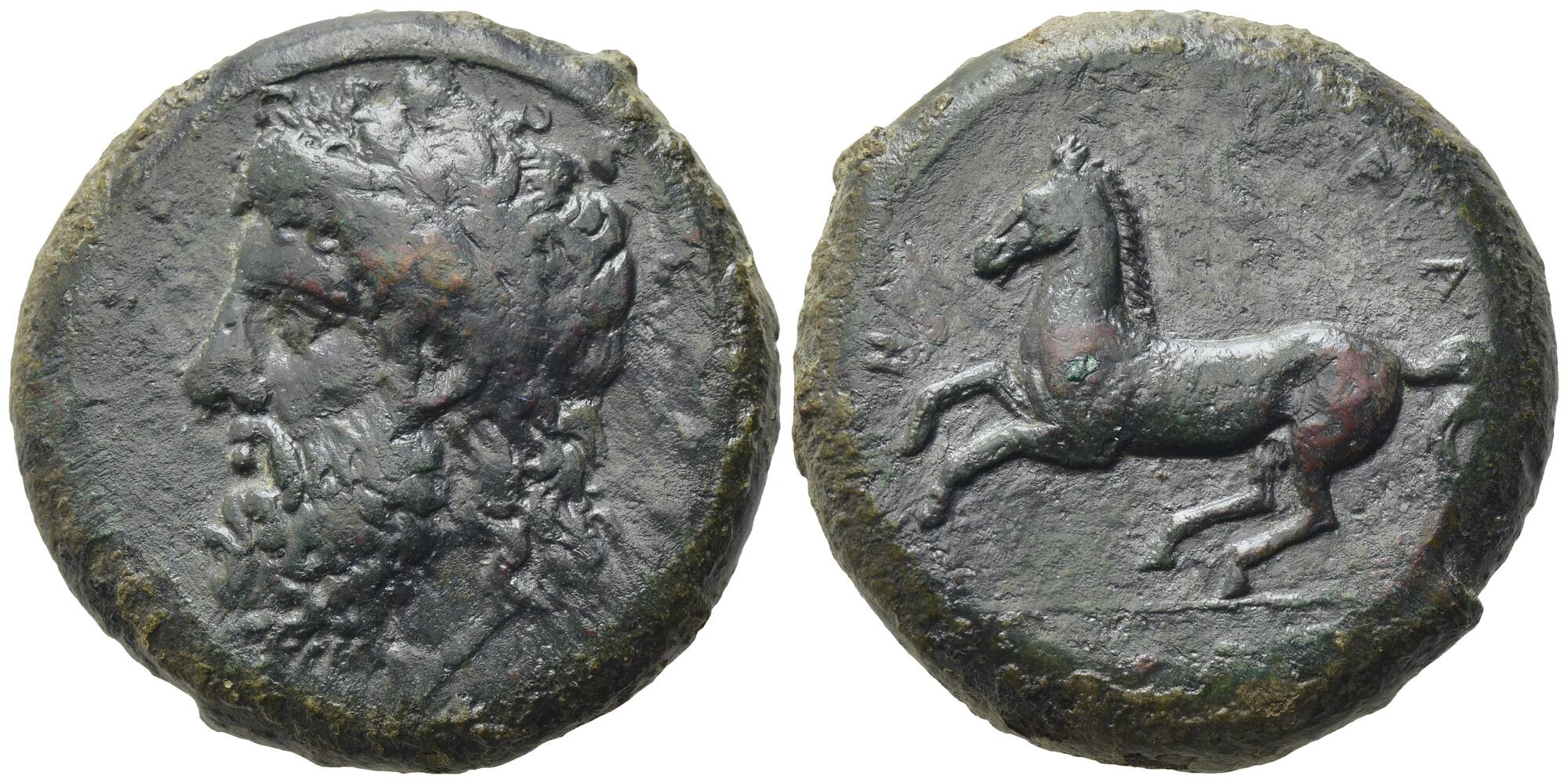335 BCE - 325 BCEΕΡΒΕΣΣΙΝΩΝ
Overstriking coin
SO 1615 - Herbessus over Syracuse.jpg
[1]
Overstruck variety
SO 2261 - Herbessos over Syracuse (Orville 1764, pl. VIII, 1) overstruck variety.jpg
|
|
Sale(s)Sale(s) ᵖ:
|
Leu, 6, 8 May 1973 (Ex Tom Virzi Collection), 110 = Triton, 5, 15 Jan. 2002 (Freedman coll.), 157 = Numismatica Ars Classica, 64, 17 May 2012, 685
|
| Private collection(s)Private collection(s) ᵖ:
|
From Tom Virzi and Freedman coll.
|
|
Description
| ObverseInscription or printing placed on the obverse.:
|
ΕΡΒΕΣΣΙΝΩΝ (Greek) Head of Sikelia right, wearing olive-leaves wreath. Linear border.
|
ReverseInscription or printing placed on the reverse.:
|
Eagle standing right, head reverted, holding snake in his beak. Border of dots.
|
Mint and issuing power
| MintIdentifies the place of manufacture or issue of a numismatic object.:
|
Herbessus
|
Ancient regionAncient region.
|
Sicily
|
Modern countryModern country: Italy
|
AuthorityIdentifies the issuing power. The authority can be "pretended" when the name or the portrait of X is on the coin but he/she was not the issuing power. It can also be "uncertain" when there is no mention of X on the coin but he/she was the issuing power according to the historical sources:
|
|
Chronology
| FromIdentifies the initial date in a range assigned in a numismatic context. 335 BCE toIdentifies the final date in a range assigned in a numismatic context.. 325 BCE
|
Classical 480-323 BC  periodTime period of the numismatic object. periodTime period of the numismatic object.
|
Physical description
MetalThe physical material (usually metal) from which an object is made.: Bronze 
|
WeightWeight of the numismatic object (in grams). in grams: 20.1320.13 g <br />20,130 mg <br />
|
DenominationTerm indicating the value of a numismatic object. Examples: tetradrachm, chalkous, denarius.: dilitron
|
|
|
|
|
References
Description
| ObverseInscription or printing placed on the obverse.:
|
ΖΕΥΣ ΕΛΕΥΘΕΡΙΟΣ (Greek) Head of Zeus Eleutherios left, wearing laurel wreath (visible on obverse)
|
ReverseInscription or printing placed on the reverse.:
|
ΣΥΡΑΚΟΣΙΩΝ (Greek) Horse galloping left (visible on reverse).
|
Mint and issuing power
Chronology
| FromIdentifies the initial date in a range assigned in a numismatic context. 339 BCE toIdentifies the final date in a range assigned in a numismatic context.. 334 BCE
|
Classical 480-323 BC  periodTime period of the numismatic object. periodTime period of the numismatic object.
|
Physical description
| DenominationTerm indicating the value of a numismatic object. Examples: tetradrachm, chalkous, denarius. ᵖ:
|
dilitron
|
|
|
References
| Frequency of overstrikesFrequency of overstrikes:
|
frequent
|
Level of confidenceLevel of confidence of the identification:
|
sure
|
| RemarksRemarks:
|
"Overstruck on a Syracusan Dilitron, Zeus/Horse (Calciati II pg. 185, 80), with the undertype clearly visible on both sides"
|
References
- ^ Calciati, Romolo (1987), Corpus nummorum siculorum. La monetazione di bronzo/The bronze coinage, vol. 3, Milan, Edizioni G. M.
- ^ Campana, Alberto (1992-2003), Corpus Nummorum Antiquae Italiae, Panorama Numismatico
- a b Hoover, Oliver D. (2012), The Handbook of Greek Coinage Series. 2. Handbook of the Coins of Sicily (Including Lipara). Civic, Royal, Siculo-Punic, and Romano-Sicilian Issues. Sixth to First Centuries BC, Lancaster-London, 489 p.
- ^ Calciati, Romolo (1986), Corpus nummorum siculorum. La monetazione di bronzo/The bronze coinage, vol. 2, Milan, Edizioni G. M.


